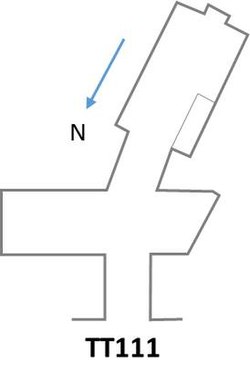The Theban Tomb TT409 is located in El-Assasif, part of the Theban Necropolis, on the west bank of the Nile, opposite to Luxor. It is the burial place of the ancient Egyptian Samut called Kyky, who was Accountant of Cattle of the Amun domain, during the reign of Ramesses II during the Nineteenth Dynasty.
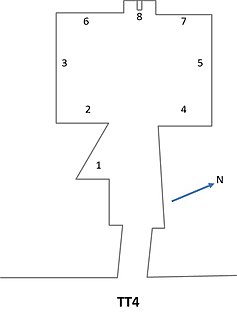
The Theban Tomb TT4 is located in Deir el-Medina, part of the Theban Necropolis, on the west bank of the Nile, opposite to Luxor. It is the burial place of the ancient Egyptian artisan named Qen.
Qen was an Ancient Egyptian artisan. Qen lived in Deir el-Medina on the west bank of the Nile, opposite Thebes, during the reigns of Ramesses II. His titles included Servant in the Place of Truth, meaning that he worked on the excavation and decoration of nearby royal tombs. He was buried in a tomb in the village necropolis.
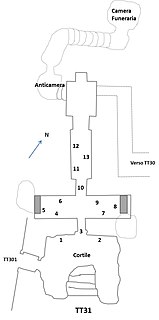
The Theban Tomb TT31 is located in Sheikh Abd el-Qurna, part of the Theban Necropolis, on the west bank of the Nile, opposite to Luxor. It is the burial place of the ancient Egyptian official, Khonsu, who was First Prophet of Menkheperre, during the 19th Dynasty or 20th Dynasty.

The Theban Tomb TT6 is located in Deir el-Medina, part of the Theban Necropolis, on the west bank of the Nile, opposite to Luxor. It is the burial place of the ancient Egyptian artisans named Neferhotep and Nebnefer, who lived during the end of the 18th and beginning of the 19th Dynasty.
Nebwenenef was High Priest of Amun at the beginning of the reign of Ramesses II during the 19th Dynasty. Prior to that, Nebwenenef had served as High Priest of Anhur and High Priest of Hathor during the reign of Seti I and possibly even earlier.

The Theban Tomb TT19 is located in Dra' Abu el-Naga', part of the Theban Necropolis, on the west bank of the Nile, opposite to Luxor. It is the burial place of the ancient Egyptian Amenmose, who was the high priest of Amenhotep of the Forecourt during the early Nineteenth Dynasty.
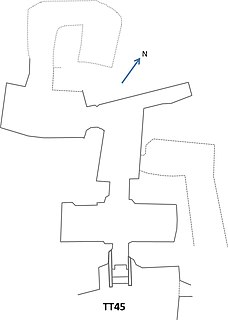
The Theban Tomb TT45 is located in Sheikh Abd el-Qurna, part of the Theban Necropolis, on the west bank of the Nile, opposite modern Luxor. It was originally the burial place of the ancient Egyptian named Djehuty (Thoth), who was a scribe of the offering-table of Mery, high-priest of Amun, head of all the weavers of Amun, and steward of Mery, high priest of Amun. Djehuty lived during the reign of Amenhotep II. He was the son of a lady also named Djehuty.

The Theban Tomb TT58 is located in Sheikh Abd el-Qurna, part of the Theban Necropolis, on the west bank of the Nile, opposite to Luxor. The tomb was originally carved for a courtier dating to the time of Amenhotep III and later usurped during the Ramesside period.
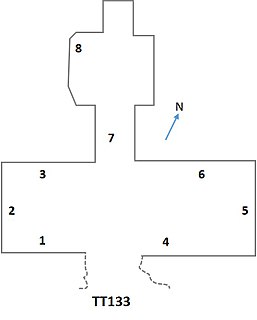
The Theban Tomb TT133 is located in Sheikh Abd el-Qurna. It forms part of the Theban Necropolis, situated on the west bank of the Nile opposite Luxor.

The Theban Tomb TT138 is located in Sheikh Abd el-Qurna, part of the Theban Necropolis, on the west bank of the Nile, opposite to Luxor.
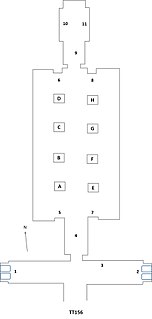
The Theban Tomb TT156 is located in Dra' Abu el-Naga', part of the Theban Necropolis, on the west bank of the Nile, opposite to Luxor. It is the burial place of the ancient Egyptian Pennesuttawy, who was a troop commander and superintendent of the Southern Desert Lands during the reign of Ramesses II in the Nineteenth Dynasty.
The Theban Tomb TT169 is located in Dra' Abu el-Naga', part of the Theban Necropolis, on the west bank of the Nile, opposite to Luxor. It is the burial place of the ancient Egyptian Senna, who was the head of the goldworkers of Amun during the reign of Amenhotep II in the Eighteenth Dynasty.

Tomb TT189 is located in the necropolis of El-Assasif in Thebes, Egypt. It contains the sepulchre of Nakhtdjehuty, who was an overseer of the carpenters of the northern lake of the god Amun and the head of the goldworkers in the Estate of Amun during the 19th Dynasty reign of Ramesses II. Nakhtdjehuty's tomb is part of the TT192 tomb complex.
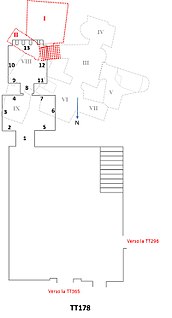
The Theban Tomb TT178 is located in El-Khokha, part of the Theban Necropolis, on the west bank of the Nile, opposite to Luxor.

The Theban Tomb TT49 is located in El-Khokha. It forms part of the Theban Necropolis, situated on the west bank of the Nile opposite Luxor. TT49 was the burial place of the ancient Egyptian official Neferhotep, who was a Chief Scribe of Amun. Neferhotep lived during the reign of Tutankhamen, Ay and Horemheb, at the end of the Eighteenth Dynasty of Egypt. He was a son of Neby, who was a servant of Amun and the lady Iuy. His wife was named Merytre

The Theban Tomb TT214 is located in Deir el-Medina, part of the Theban Necropolis, on the west bank of the Nile, opposite to Luxor.
The Theban Tomb TT385 is located in Sheikh Abd el-Qurna, part of the Theban Necropolis, on the west bank of the Nile, opposite Luxor. It is the burial place of the ancient Egyptian Hunefer (Haunefer), who was a Mayor of the Southern City (Thebes) during the reign of Ramesses II in the Nineteenth Dynasty.
Khonsu called To who was First Prophet of Menkheperre, during the reign of Ramesses II in the 19th Dynasty

Tomb A.24 is the modern number given to a now lost Theban tomb in Dra' Abu el-Naga'. The burial dates to the ancient Egyptian 18th Dynasty and belongs to the second priest of Amun Simut. The tomb was already known in the early 19th century and was visited by several early travelers, such as Jean-François Champollion and John Gardner Wilkinson. Especially the latter made several copies of the painted decoration. He seems to have seen the tomb in a fairly good state of preservation while it was already more destroyed when Jean-François Champollion came later. He copied some inscriptions. Several scenes can be reconstructed from these early accounts. There was a depiction showing the family of Simut receiving offerings, most likely in connection with a festival, called the Valley festival. The second scene shows the family of Simut hunting in the marshes. The scene was drawn by John Gardner Wilkinson and later published by him. A third scene must have shown vintage. Wilkinson only copied a small detail. Another scene seems to have shown Simut in front of scribes, men weighing and Nubians bringing tribute. The scene most likely relates to the office of Simut, who most likely also looked after the magazines of the Temple of Amun in Karnak.
